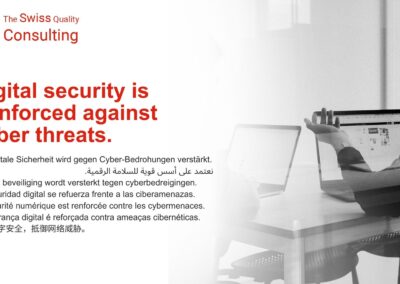Shaping a Robust Judicial Independence System Through Change Management and Leadership
The quote “For the first half of this century, High Court judges have been cautious to the point of timidity in expressing any criticism of governmental action; the independence of the judiciary has been of a decidedly subordinate character” underscores the delicate balance between the judiciary and governmental actions. In this article tailored for business executives, mid-level managers, and entrepreneurs, we explore the parallels between the evolution of judicial independence and the principles of change management, leadership, and effective communication in the corporate world.
Change Management: Navigating the Transformation of Judicial Independence
Imagine, for a moment, a scene frozen in time: a towering courthouse bathed in sepia tones, its halls echoing with the clatter of quill pens and the stern pronouncements of robed figures. This was the judiciary of eras past, its independence etched in parchment pronouncements and bolstered by the weight of tradition.
But fast-forward to the present, and the scene shifts: pixels dance across courtroom screens, algorithms parse legal briefs, and social media erupts in real-time reactions to judicial pronouncements. In this digital age, the very perception of judicial independence has undergone a profound transformation.
Just as organizations must navigate the turbulent waters of change, so too must the judiciary adapt to new realities. Change management, with its principles of structured transitions and embracing innovation, offers invaluable guidance in this dance of adaptation.
Gone are the days of pronouncements delivered from an ivory tower. Today, judges engage in public outreach programs, demystifying the judicial process and fostering transparency. Social media platforms become forums for open dialogue, where nuanced legal arguments compete for public attention. And data analytics tools, once the domain of corporations, now assist judges in navigating the complexities of evidence and precedent.
This isn’t to say that tradition stands abandoned. The core principles of judicial independence – impartiality, accountability, and the rule of law – remain the unyielding pillars of the system. But the tools with which these principles are upheld have evolved. It’s a delicate balancing act, where the timeworn scales of justice are recalibrated for the digital age.
There are, of course, challenges along the way. Concerns about judicial activism, the potential for online pressure to sway verdicts, and the ever-present specter of misinformation all pose real threats to the delicate equilibrium of judicial independence.
But amidst these challenges lies an opportunity. Just as change management empowers organizations to emerge stronger from periods of flux, so too can the judiciary harness the tools of the digital age to solidify its role as a cornerstone of democracy. By embracing transparency, engaging with the public, and leveraging technology responsibly, the judiciary can build a future where its independence not only endures but thrives, its scales gleaming anew in the light of the digital age.
Ensuring an independent judiciary requires a systematic approach to change. Judges, like corporate leaders, must champion transparency, accountability, and a commitment to upholding the principles of justice. By embracing change management strategies, the judiciary can reinforce its independence and adapt to the evolving demands of the 21st century.
Leadership and Management Skills: Upholding Judicial Integrity
Leadership and management skills are essential in upholding the integrity of the judiciary. High Court judges, much like corporate leaders, must demonstrate unwavering commitment to their principles while navigating complex legal landscapes.
Effective leaders within the judiciary cultivate a culture of independence, where judges can express their views without fear of reprisal. Leadership skills play a crucial role in fostering an environment where judges are empowered to fulfill their roles as guardians of justice, free from external pressures.
Effective Communication: Bridging the Gap Between the Judiciary and the Public
The quote alludes to a historical reluctance in expressing criticism. However, in the contemporary era, effective communication has become paramount for the judiciary to maintain public trust and confidence.
High Court judges, much like corporate executives, must communicate decisions transparently and in a manner understandable to the public. Bridging the gap between legal language and public understanding enhances the judiciary’s credibility and reinforces the perception of independence.
Risk Management Strategies: Safeguarding Judicial Independence
Risk management strategies are crucial in safeguarding judicial independence. Judges face the risk of external influences impacting their decisions, posing a threat to the impartiality of the judiciary.
Implementing robust risk management strategies involves identifying potential threats to judicial independence and implementing safeguards. This parallels corporate strategies where anticipating risks and implementing preventive measures is crucial for long-term success.
Strategic Planning: Charting the Course for Judicial Independence
Similar to corporate entities that engage in strategic planning, the judiciary must chart a course that ensures its independence for future generations. Strategic planning involves anticipating challenges, setting clear objectives, and developing a roadmap for the judiciary’s evolution.
Judges, much like business leaders, must engage in strategic thinking to navigate the complexities of legal, social, and political landscapes. By strategically planning for the future, the judiciary can proactively address challenges to its independence.
Conclusion: Upholding the Pillars of Justice
In conclusion, the quote prompts reflection on the journey of judicial independence in the 21st century. Drawing parallels with change management, leadership and management skills, effective communication, risk management strategies, and strategic planning in the corporate world, we see a shared commitment to upholding the pillars of justice.
For business executives, mid-level managers, and entrepreneurs, understanding the dynamics of judicial independence offers valuable insights into managing change, fostering leadership, and navigating the delicate balance between autonomy and external influences.
#JudicialIndependence #ChangeManagement #LeadershipSkills #EffectiveCommunication #RiskManagement #StrategicPlanning #LegalSystem























